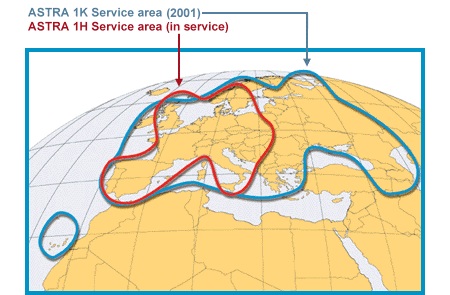Two way High Debit- Internet satellite terminal
BROADBAND INTERACTIVE
Communication needs are changing...and to meet these needs, SES is launching the Broadband Interactive System (BBI). Offering two-way broadband connectivity via satellite, BBI has been built with the solution provider in mind, offering send and receive capabilities for data, audio or video -- quickly and reliably. It is a perfect fit for networks with remote sites within the ASTRA coverage area!
Flexible: BBI supports all standard IP-based business needs such as file transfers, e-mail, database access/updates and Internet access. BBI extends terrestrial connectivity to remote locations throughout Europe via the ASTRA Satellite System, avoiding the need for multiple ISPs or telecos to provide connectivity.
Cost Effective: Send Once...Reach Many! By being able to multicast -- sending one satellite transmission to many recipients -- or by using bandwidth on an as-needed basis only, ensures BBI is a cost-effective solution.
THE BROADBAND INTERACTIVE SYSTEM (BBI)
The ASTRA Broadband Interactive System (BBI) is an open and neutral technology platform, offering users receive and transmit capabilities from the ASTRA Satellite System. Users will be able to receive data, video and audio at speeds of up to 38 Mbit/s. And the return channel from the users, sent via a Satellite Interactive Terminal (SIT) will transmit at speeds of up to 2 Mbit/s. BBI is optimized for asymmetric two-way communications (for example, for broadcasting or multicasting with interactive capabilities) and is based upon IP protocols, supporting all common standard Internet applications.
BBI will provide collection, storage and hosting of multimedia content and will route the individual services to their final destinations. Content contributions can be broadcast or multicast to dedicated user groups. As well, BBI can provide external connectivity to other terrestrial or satellite networks.
SES is working actively with industry, service providers, operators, standardization bodies and regulatory authorities to ensure that BBI is compliant with widely accepted existing and emerging technical standards (e.g. ETSI, DVB and DAVIC). BBI will use the Ka-band frequencies of the ASTRA 1H satellite at 19.2° East. These frequencies, namely 29.5 - 30.0 GHz from the user's premises, have a worldwide exclusive allocation to the Fixed Satellite Service (FSS) by the International Telecommunications Union (ITU).
THE NETWORK ARCHITECTURE
The BBI infrastructure offers service providers, application developers and value added resellers an asymmetric IP based high-speed two-way communications system via the ASTRA Satellite System. BBI has a star architecture and is capable of point-to-point and multipoint connectivity within the ASTRA coverage area. The BBI hub has powerful processing and storage capabilities and can act as a gateway to connect to external networks. The SIT, installed at the user's premises, supports standard IP-based needs such as:
- High Speed Internet access
- File transfer and multicast content distribution -- video, audio and data
- Data collection -- including store-and-forward capabilities

Coverage
Active today on the ASTRA 1H satellite, the BBI system will start commercial trials with identified customers. BBI will serve the growing market demand for two-way high-speed broadband collection and delivery of multimedia data for large to small businesses, the public sector and consumers in Western and Central Europe.
ASTRA 1K, which is scheduled for launch in 2001, will further enhance the ASTRA Broadband Interactive System by extending the geographical coverage in Western and Central Europe towards Eastern Europe and part of the Commonwealth of Independent States (CIS) from the ASTRA prime orbital position of 19.2° East.

The Hub
The hub transmits a standard Ku-band DVB-S/MPEG-2 signal of up to 38 Mbit/s that will provide multimedia services to selected user groups. It also facilitates collection, storage and hosting of multimedia data which can then be routed to their final destinations. The hub can also provide external connectivity to other terrestrial or satellite networks.
The BBI satellite access protocol is based upon Multi-Frequency Time Division Multiple Access (MF-TDMA) and allows each SIT to dynamically request the satellite capacity required to transmit its applications. This bandwidth-on-demand functionality also ensures that the user is only charged for actual usage of the capacity. The hub will allocate the necessary time and frequency slots to the individual SITs and will provide synchronization information to the BBI network.
The SIT

The Satellite Interactive Terminal (SIT) consists of a fixed, small antenna and an Indoor Unit (IDU). The IDU can be connected to a standalone multimedia PC or a Local Area Network. The SIT can transmit data rates of up to 2 Mbit/s in the Ka-band spectrum (29.5 - 30.0 GHz) and it has a receive capability for data rates of up to 38 Mbit/s. All communications are based on the IP protocol, providing a transparent environment which supports standard Internet technologies. In addition, the industry standard IPSec and its associated key distribution mechanism provide end-to-end security.
| SIT
OPTIONS Various terminals are available to suit users transmission needs |
||
| Dish size | Maximum Transmit Bitrate |
DVB MPEG-2 Receive Bitrate |
|---|---|---|
| 65 - 75 cm | 144 kbit/s | 38 Mbit/s |
| 75 - 95 cm | 384 kbit/s | 38 Mbit/s |
| 95 - 130 cm | 2,048 kbit/s | 38 Mbit/s |
| < < < |